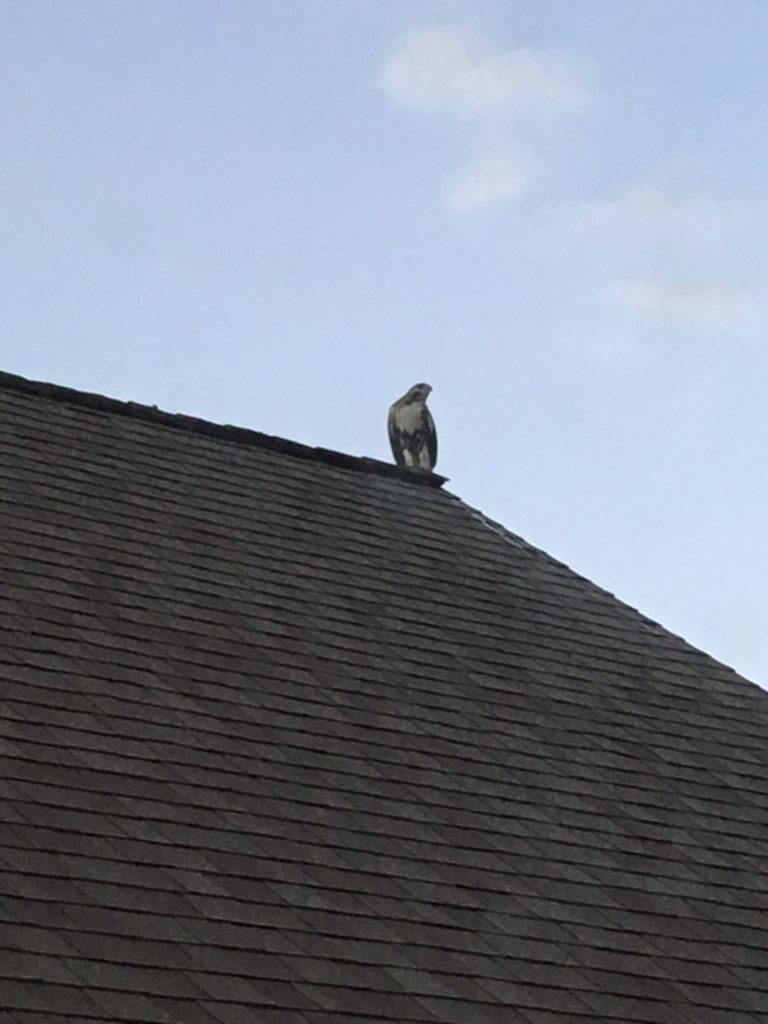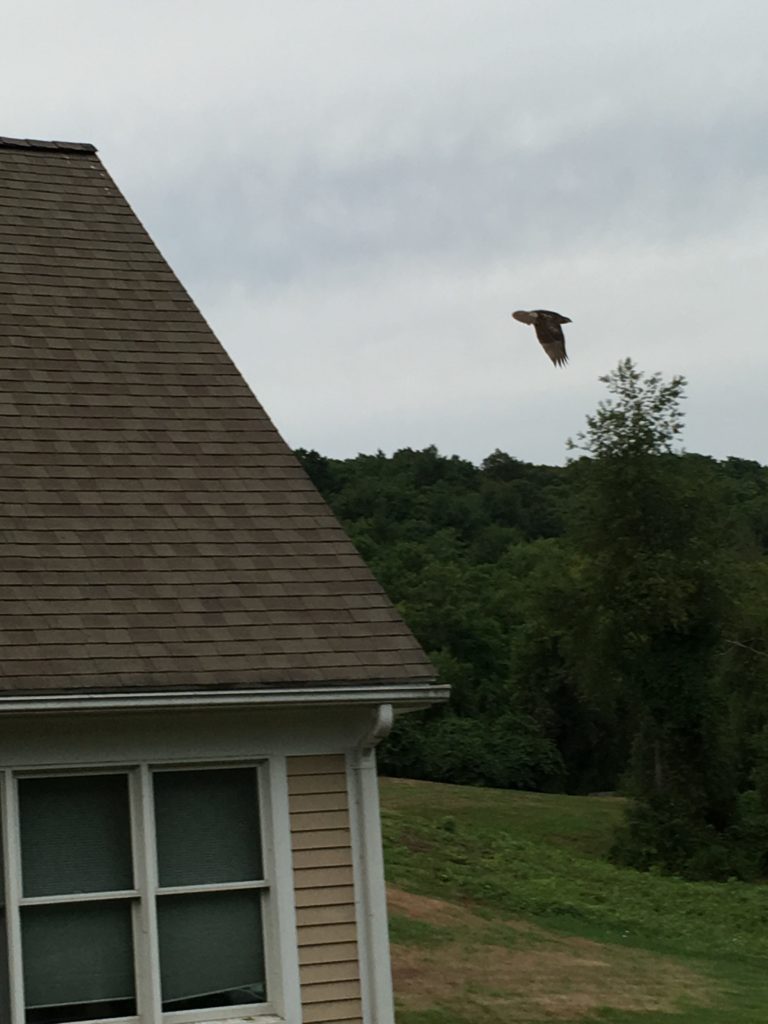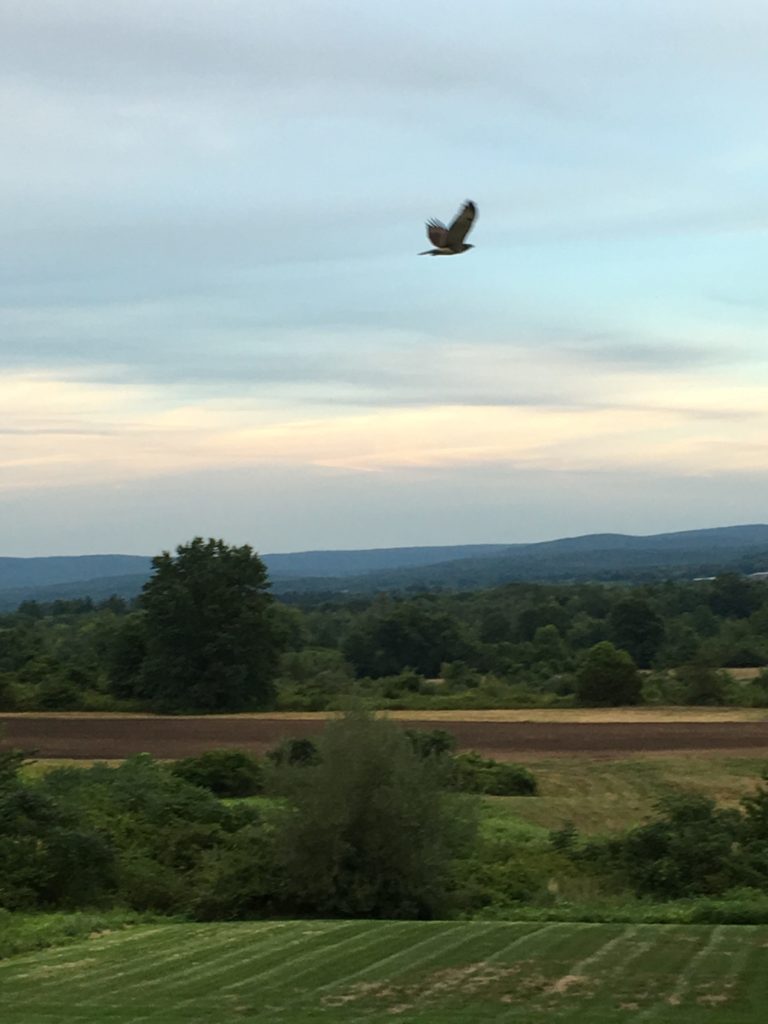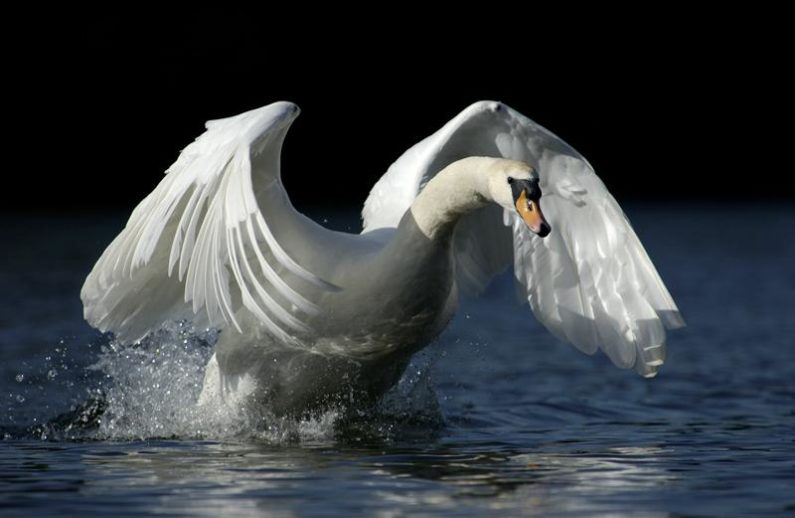My wife talks to birds.
No, that isn’t quite right. It’s not that she talks to them. They converse.
Not in words, like “squawk squawk squawk” equals “how are you doing today?” They converse in the same sense that dancers converse. They show up on the scene, in her life, like punctuation marks, marking significant moments, commenting on events of the day with the gesture of their presence.
For example, hawks. Hawks are, more than any other species, her bird. At moments when she is doubting herself, or contemplating a path she is thinking of taking, a hawk will suddenly show up. As if to say, Don’t worry. That question of yours? The answer is, yes.
Like this one, who appeared on our roof the other day …

Then took off …

And flew across our backyard.

And it’s not just hawks. Driving into Tampa one day, we had just reached a point in our conversation where we were talking about something vitally important to our future — a sort of “Should we do this or not?” moment — and as we headed onto an access road, a bald eagle burst up from the grasses right beside the ramp and soared straight across our windshield, just feet from our eyes, then took off into the blue.
We looked at each other. “I’ll take that as a Yes,” we both said.
Ana’s father’s favorite bird was the cardinal. Ever since his passing, in 2006, cardinals keep showing up in our yard. Ana’s mom passed in 2014. Now they show up in pairs.
Hey there. You’re not alone.
For me, it’s catbirds. They tend to follow me around. They may actually be mockingbirds, I’m still not entirely sure. But whatever they’re called, man, do they sing. (As I wrote about here.)
I’ve been thinking about birds and their personal implications because I’ve come under the moody, mesmerizing spell of Jean Sibelius.
Sibelius, possibly Finland’s most famous citizen, was a great nineteenth-/twentieth-century composer, yet one, for whatever weird accident of fate, whom I never listened to or knew much of anything about. Lately I’ve been listening, and falling in love. First, his string quartet in D minor, and now, his great fifth symphony.
Finns are typically close to nature, far closer than the average American. Even for Finns, though, Sibelius was especially keenly attuned to the natural world and responded with deeply personal intensity to its colors and sounds and smells, its moods and shifts. In particular, he had a deep affinity with birds.
One day in 1915, when the composer was nearing fifty, he saw a ballet of swans all taking flight at once:
“Today at ten to eleven I saw sixteen swans,” he wrote in his diary. “God, what beauty! They circled over me for a long time. Disappeared into the solar haze like a silver ribbon.”
Then in the midst of composing his great fifth symphony, commissioned for his fiftieth birthday, Sibelius caught and immortalized the haunting sound of those swans calling to each other in a magnificent passage in the symphony’s last movement, in a series of rising and falling chords in the horns, and later the trumpets and then oboes:

So what, exactly, does this all mean?
What were the sixteen swans “saying”? What did it mean when the eagle burst across our line of sight on the Tampa highway? What does it mean when a pair of cardinals shows up right outside our window and stares at Ana? Or when a catbird hops from tree to tree, following me as we walk the neighborhood?
I don’t want to get too literal about that question, in the same way that you don’t want to get too exact about saying exactly what a Beethoven string quartet, or a Van Gogh canvas, or a stunning sunset “means.”
To me, it comes down to how you see yourself in the world: whether you see the world as a backdrop, a stage you observe and within which you move … or as something that observes you back.
As something that dances with you, and not just around you or behind you.
You can call it nature, or you can use the word God, or trot out terms like noosphere or Tao or universe. However you say it, my sense is that the world around you is having a conversation with you, right now, and always.
It’s like a ringing phone. All you just have to do is pick up.
And converse.
When Hugh Lofting’s Dr. Doolittle was first told by the parrot Polynesia that animals could talk, he was astonished. “I knew that parrots could talk,” he says. She points out that the dog, Jip, is talking to the doctor at that very moment.
“Looks to me as though he were scratching his ear,” says the Doctor.
“But animals don’t always speak with their mouths,” she explains. “They talk with their ears, with their feet, with their tails—with everything.”
So they do. So does the world. And I think it’s doing so all the time.
“Laugh,” they say, “and the whole world laughs with you. Cry, and you cry alone.”
So not true!
Yes, perhaps the whole world does laugh with you. (Maybe that’s what that catbird is doing.) But when you cry? I think the whole world leans in and offers its shoulder to cry upon as it murmurs words of comfort into your ear.
Take Sibelius, for example.
The man struggled so with composition that, for the last thirty years of his life, he hardly published a single finished composition, and destroyed many of his notes and sketches. These were not easy years. Then one day, when he was ninety-one, he was out taking his customary walk when he witnessed a flock of cranes approaching. “There they come,” as he later described the scene to his wife. “The birds of my youth!”
Suddenly, one of the birds broke away from the rest of the formation, rose in the air, and flew one great circle high above the composer … then rejoined the flock as they continued on. Sibelius was profoundly touched.
Two days later, he was gone.
I don’t want to presume to say what those birds “meant.” But I like to think they were whispering words of comfort to the troubled old man, and that those words were with him still when he burst into flight and soared away.
Photo of swan taking flight © Malcolm Schuyl, from his book The Swan: A Natural History.


I have been seeing butterflies lately. I feel they are trying to tell me something. Uncertain what. As to Sibelius, I love this from Sarah Chang. https://www.youtube.com/watch?v=gpS_u5RvMpM Thanks for the reminder John of how much I love Sibelius!
Ha! Keep listening. Love it. And that’s a beautiful video, with Sarah Chang. Here is the Fifth Symphony: https://www.youtube.com/watch?v=V8qiAMOiygs — the swan calls come in at about 23:53. And by the way, here is my favorite rendition of the string quartet I mentioned: https://www.youtube.com/watch?v=agr4_3qLYxE — the Emerson Quartet, with my old childhood friend (and one-time cello teacher) David Finckel on the cello.
You never cease to amaze me with the wonderful pictures you place in your story telling. Love each story, they uplift and fill my heart with joy. Thanks John David!
You are so welcome, MaryJo — so happy to hear from you!
Your words are like a beautiful piece of music, John!
Ever since my Mom died (almost 30 years ago), whenever I see a Monarch butterfly, I think it’s her saying “Hey Lin!”
Since moving to the Jersey shore (you remember that place, right?) the butterfly has been replaced with seagulls. And it’s not just that they show up; it’s how and when they show up, usually in pairs (my Dad died shortly after my Mom), often symmetrically http://pin.it/vOqBX4I and always when I need a whooooosh of inspiration.
Thanks, Linda — always great to see you here! (And you’re right: how could a Jersey-raised boy ever forget the Jersey shore?)
A beautiful story John — posted on our parents’ 68th wedding anniversary! In early June 1995, just after we said good-bye for the last time to Mom, I was in my study, numb with the loss. Suddenly, a green-blue hummingbird appeared right in the center of the plate-glass window. It hovered there, seemingly looking straight at me, for at least a full minute — then flew away. Nothing like that has happened to me before or since, but I’m convinced she was somehow trying to comfort me … and it worked!
Oh, that is a stunning story! I can just see that hummingbird hovering there, waiting to make sure you had received the message … poignant indeed! As it happens, it was also Ana’s parents’ anniversary — yep, the very same day. So hummingbirds, cardinals, and any other of God’s creatures who might be listening: party on!